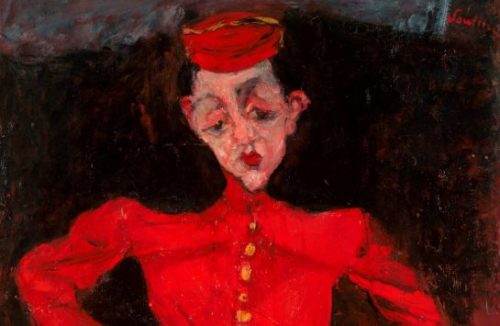Paris is often romanticized as a dream-like vision; the bustling banks overflow with cafés as sophisticated Parisian dwellers enchant our imagination. Chaïm Soutine addresses this imagined ideal of the Parisian streets with his vivid portraiture in Soutine’s Portraits: Cooks, Waiters and Bellboys, which depicts the quotidian worker in Paris thus highlighting the mundane and unglamorous. Soutine personally related to these workers he depicted; after emerging as an acclaimed artist in 1922 after years of humble work, Soutine felt out of place in this new bourgeois realm. Through acute attention to his subjects’ uniforms, Soutine reveals a complex narrative of both the discomfort of the service men and women he depicts in their high-class workplace, and his own apprehension about his newfound fame. Both uncomfortable in their given uniforms, Soutine and his subjects feel like outsiders in a bourgeois society.
The pair of galleries on the top floor of the Courtauld Gallery guide the viewer on a rich visual journey through twenty-one of Soutine’s portraits organized primarily by his sitter’s occupation. Soutine’s thick application of velvety reds and dark blues dominate the majority of the portraits’ backgrounds and bring a richness and warmth to the space that feel secure and familiar. This visual ease juxtaposes with the discomfort of the subjects in the portraits.
Soutine’s sitters, primarily valets, bellboys, pastry cooks, waiters, or chambermaids, appear deeply uncomfortable. Their bodily proportions are distorted in an unsettling manner, their facial expressions are scornful, and their brows are furrowed—all projecting to the viewer the discomfort in their uniform both physically and emotionally. The subjects look tense in their dress, and their uniforms appear stiff and ill-fitting. This is particularly poignant in The Chambermaid and Valet.

The Chambermaid’s hands are clasped tightly in front of her apron, her elbows stiffly pinned to her side. Her rigid stance draws attention to her pink dress and white apron, which, as a chambermaid, needed to be pristine at all times to tend to hotel duties. The woman’s face is tired, and her tense body language suggests a discomfort in her role.

The Valet’s white apron, blue coat, and red vest envelop his figure. The red fabric surrounding his torso bunches to his right side, and his blue coat sleeves billow around his elbows and upper arms. Soutine’s wide brush strokes convey the folds in the valet’s white apron and mirror the wide fit of his uniform as a whole. The Valet’s ill-fitting uniform and disdainful expression suggest a similar discomfort and unhappiness in his role.
While coexisting in the realm of the Parisian bourgeois, Soutine and his sitters were uncomfortable in their uniforms. This tension suggests Soutine felt awkward and tense stepping into a position of great wealth and privilege, and related to the unpresuming service workers, who also felt a sense of discomfort. Through focusing on the dress of Parisian service workers, Soutine was able to channel some of his anxieties about his new uniform just as his subjects’ were confronted with their own.
The Courtauld Gallery’s Soutine’s Portraits: Cooks, Waiters and Bellboys on view until 21 January 2018.
By Arielle Murphy


